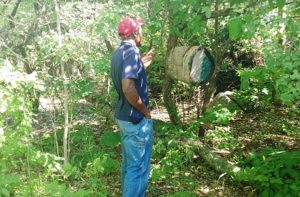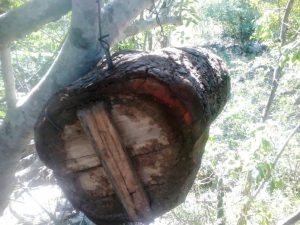Why Farmers in Zimbabwe Are Shifting to Bees
By Andrew Mambondiyani, originally published by YES! magazine
 Smallholder farmers in Village M—a farming community south of the eastern border city of Mutare in Zimbabwe—have, for years, enjoyed bumper harvests of maize and other crops. However, the abundant yields in Village M and surrounding communities have diminished considerably over the past 20 years. Large swathes of previously productive farmland now lie neglected, overrun by rough thickets of sickle bushes.
Smallholder farmers in Village M—a farming community south of the eastern border city of Mutare in Zimbabwe—have, for years, enjoyed bumper harvests of maize and other crops. However, the abundant yields in Village M and surrounding communities have diminished considerably over the past 20 years. Large swathes of previously productive farmland now lie neglected, overrun by rough thickets of sickle bushes.
Several areas across Zimbabwe have been ravaged by severe climate change-induced droughts. A 2021 study revealed that Zimbabwe’s temperatures rose 1 degree Celsius between 1960 and 2000, while annual rainfall decreased 20% to 30%. Experts estimate that climate change will reduce agricultural production in Sub-Saharan Africa by 10% to 20% by the year 2050.
But Lazarus Mwakateve, a smallholder farmer from Village M, has diversified his operation to offset crop losses from droughts. He ventured into beekeeping more than a decade ago, largely as a pastime, but the enterprise has since morphed into a lucrative alternative source of income for him.
“Beekeeping does not need large pieces of land or large amounts of water like crop farming,” Mwakateve says.
Many other farmers are following in Mwakateve’s footsteps. Experts say there are more than 50,000 beekeepers in Zimbabwe today.
Mwakateve has 53 beehives, and as of last September, he says 26 of them had bees and honey. Each beehive provides between 33 and 35 liters of honey each year. And each liter of honey earns Mwakateve US$3.20 when he sells them to middlemen.
“Droughts reduce income from crops down to zero in some cases, but income from honey has remained stable even during the worst droughts,” Mwakateve says.
Honey Harvesting on the Rise
Village M is an enclave tucked at the foot of Gombai mountain. Nearby, the Mushaamhuru River snakes sluggishly along the heavily silted riverbed as it heads toward its confluence with the Mpudzi River. Rain-fed crop farming has long been the mainstay of these communities, but changing climate is putting Zimbabweans—some 70% of whom depend entirely on agriculture or rural economic activities—in jeopardy.
However, local demand for honey is growing both on the formal and informal markets. The day before Christmas in 2022, I witnessed an informal honey seller roving around a local business center, Gutaurare, selling honey from a 25-liter plastic container. Such informal honey sellers are now a common sight in the streets of the city of Mutare.
Techniques
To succeed in this new enterprise, Mwakateve says beekeepers must acquire knowledge on beekeeping and honey harvesting techniques.
“Our traditional ways of harvesting honey are not good for bees,” he says. This involves using fire to smoke out the bees, which ends up killing large numbers of them. But new techniques, like bee smokers and bee suits, are gentler on the bees while still protecting the beekeepers.

Traditional beehives in eastern Zimbabwe. Photo by Andrew Mambondiyani
To read the complete article go to;
Why Farmers in Zimbabwe Are Shifting to Bees – Resilience
We are here to share current happenings in the bee industry. Bee Culture gathers and shares articles published by outside sources. For more information about this specific article, please visit the original publish source: Why Farmers in Zimbabwe Are Shifting to Bees – Resilience








